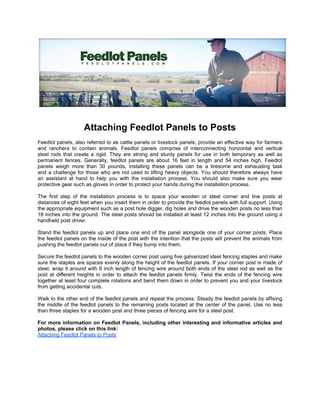
Attaching Feedlot Panels to Posts
- 1. Attaching Feedlot Panels to Posts Feedlot panels, also referred to as cattle panels or livestock panels, provide an effective way for farmers and ranchers to contain animals. Feedlot panels comprise of interconnecting horizontal and vertical steel rods that create a rigid. They are strong and sturdy panels for use in both temporary as well as permanent fences. Generally, feedlot panels are about 16 feet in length and 54 inches high. Feedlot panels weigh more than 30 pounds, installing these panels can be a tiresome and exhausting task and a challenge for those who are not used to lifting heavy objects. You should therefore always have an assistant at hand to help you with the installation process. You should also make sure you wear protective gear such as gloves in order to protect your hands during the installation process. The first step of the installation process is to space your wooden or steel corner and line posts at distances of eight feet when you insert them in order to provide the feedlot panels with full support. Using the appropriate equipment such as a post hole digger, dig holes and drive the wooden posts no less than 18 inches into the ground. The steel posts should be installed at least 12 inches into the ground using a handheld post driver. Stand the feedlot panels up and place one end of the panel alongside one of your corner posts. Place the feedlot panels on the inside of the post with the intention that the posts will prevent the animals from pushing the feedlot panels out of place if they bump into them. Secure the feedlot panels to the wooden corner post using five galvanized steel fencing staples and make sure the staples are spaces evenly along the height of the feedlot panels. If your corner post is made of steel, wrap it around with 6 inch length of fencing wire around both ends of the steel rod as well as the post at different heights in order to attach the feedlot panels firmly. Twist the ends of the fencing wire together at least four complete rotations and bend them down in order to prevent you and your livestock from getting accidental cuts. Walk to the other end of the feedlot panels and repeat the process. Steady the feedlot panels by affixing the middle of the feedlot panels to the remaining posts located at the center of the panel. Use no less than three staples for a wooden post and three pieces of fencing wire for a steel post. For more information on Feedlot Panels, including other interesting and informative articles and photos, please click on this link: Attaching Feedlot Panels to Posts
